Unicef: Children’s wellbeing, learning outcomes ‘inextricably linked’
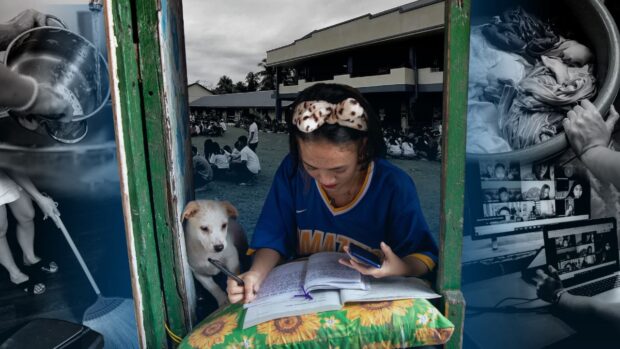
COMPOSITE IMAGE: DANIELLA MARIE AGACER FROM REUTERS, AFP, STOCK PHOTOS
MANILA, Philippines—Southeast Asia, including the Philippines, faces a lot of challenges, like poverty and lack of access to quality education, which the United Nations Children’s Fund (Unicef) said are inextricably linked to children’s learning outcomes.
According to analysis of results of the Southeast Asia Primary Learning Metrics (SEA-PLM) 2019, which was released this year, most Filipino Grade 5 students do not have the minimum reading and mathematical skills expected at the end of primary education.
READ: Southeast Asia rank: PH 2nd to worst in Grade 5 students’ reading, math skills
Unicef had stressed that because of this, there is an immediate need to harness the potential of early childhood education as it was expected to provide a “vital foundation for lifelong learning.”
However, in its second analysis of the findings of the latest SEA-PLM, Unicef stated that there is a “crucial link between children’s learning outcomes and their overall wellbeing,” too.
RELATED STORY: WB: PH ‘learning poverty’ among highest in region
According to Unicef, the secondary research showed that “children who perform well academically tend to have better social and emotional wellbeing, as well as better physical health.”
Conversely, “those who struggle with their studies are at a higher risk of experiencing mental health problems and poorer health outcomes,” Unicef said as it released its latest report “What Does SEA-PLM 2019 Tell Us About Child Well-Being and Learning in Six Southeast Asian Countries?”
The report delved into the relationship between Grade 5 students’ wellbeing and learning in six countries in the region, including the Philippines, and identified key factors that contributed to better outcomes in these learning areas:
- Reading
- Writing
- Mathematics
Lack of reading, math skills
Through the Sustainable Development Goals (SDGs), the UN in 2016 called for access to quality basic education for all children, including some 30 million learners in the Philippines.
As the UN stressed, this was to lead students to relevant learning outcomes and equip them with required skills, especially in language and mathematics, as early as kindergarten.
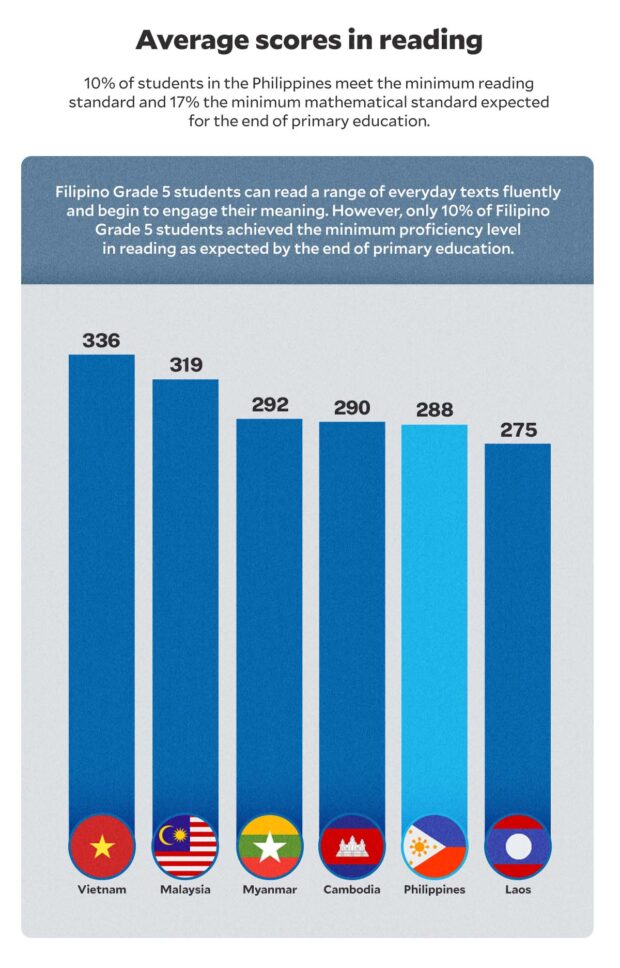
GRAPHIC Ed Lustan
This, as only 10 percent of students in the Philippines met the minimum reading standard and 17 percent met the minimum mathematical standard expected at the end of primary education, as provided in SDG 4.1.1—Education Proficiency.
Filipino Grade 5 students received an average score of 288 in reading assessment, which means that they can read a range of everyday texts fluently and comprehend their meaning.
The problem, however, is that only 10 percent achieved the minimum proficiency level, which is the ability to understand texts with familiar structures and manage competing information.

GRAPHIC Ed Lustan
When it comes to mathematics assessment, Filipino Grade 5 students also received a score of 288, indicating that they can generally apply number properties and units of measurement.
But, like the result in the reading assessment, Unicef said only 17 percent had the ability to perform mathematical operations, including fractions and interpret tables and graphs.

GRAPHIC Ed Lustan
As to writing assessment, Filipino Grade 5 students also received a score of 288, suggesting that a student can produce very limited writing with fragmented ideas and inadequate vocabulary as some 46 percent fell to the lowest proficiency band in writing.
Wellbeing and better learning
Unicef said “the link between a child’s wellbeing and learning outcomes is mutually reinforcing and interconnected” as studies have shown that children with higher levels of wellbeing have higher levels of academic engagement and achievement.
“These wellbeing domains are critically important during the impressionable stage of early adolescence, when rapidly occurring physical, emotional and social changes affect children’s well-being and learning,” it said.
As explained by Unicef, its secondary research, which was derived from the findings of the SEA-PLM 2019, took a closer look at the relationship between learning and wellbeing across these key factors:
- Mental wellbeing, which included household environment (parental engagement, parental expectations, learning resources), social environment at school (peer relationships, attitudes towards school, children’s voices) and exposure to violence at school
- Physical wellbeing, which included children’s time use and activities (out-of-school activities, time to get to school, facilities at school, facilities in the local community), and health and nutrition (meals on a normal day, access to WASH at school)
- Social and environmental context, which included worries about the environment (environmental concerns) and learning about the environment (learned some/a lot at school about environmental issues, taking action, responsibility)
The analysis considered that “a child’s wellbeing is influenced by objective and subjective factors including: their own actions, experiences and relationships; the networks and resources of their caregivers; and public policies and national context.”
Parental engagement, access to books
The first factor, which is a conducive home environment with more parental engagement and access to books, resulted in better learning outcomes in Southeast Asia, based on findings from these six participating countries:
- Cambodia
- Lao PDR
- Malaysia
- Myanmar
- Philippines
- Vietnam
However, Unicef said across the six participating countries, the Philippines “notably showed the highest gap in outcomes between children of highly engaged parents and children of low-engaged parents.”
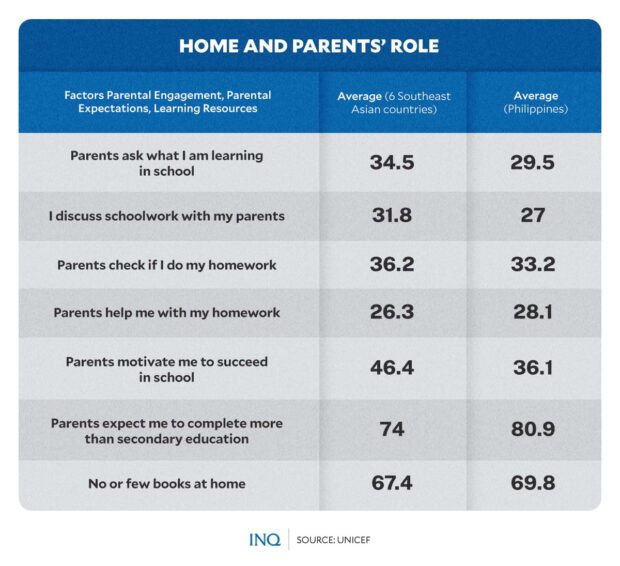
GRAPHIC Ed Lustan
Based on SEA-PLM 2019 data, the percentage of children with parents who ask what their children learn in school was 29.5 percent, lower than the 34.5 percent regional average.
Unicef said parental engagement in children’s learning differed by country, with children in Vietnam having the highest percentages in almost all forms of engagement compared with the rest of the countries included in the report.
On access to books, 69.8 percent of Grade 5 students in the Philippines had no or few books at home, slightly higher than the 67.4 percent regional average but way lower than Cambodia’s 69.4 percent, Malaysia’s 83.9 percent, and Lao PDR’s 83 percent.
Likewise, there were more students in the Philippines who stated that their parents expect them to complete more than secondary education at 80.9 percent, which is higher than the 74 percent regional average.
But at the same time, the Philippines had the least percentage of parents who motivate their children to succeed in school as its 36.1 percent was way lower than the five countries’ 58.5 percent, 50.7 percent, 48.6 percent, 48 percent, and 40.5 percent.
As explained by Unicef, previous literature suggested that these factors are positively linked with learning because “when students are happy, their anxiety decreases, health is better, school attendance and performance improve, and relationships are easier.”
Safe schools
A safe and supportive school environment plays a big role in learning outcomes, too.
Unicef said data indicated that a sense of belonging, security, and purpose at school helped children perform better. Conversely, lower scores and quality of life were associated with exposure to violence at school.
SEA-PLM 2019 data showed that on average, almost nine out of 10 children in the region found it easy to make friends at school, regardless of gender or location.
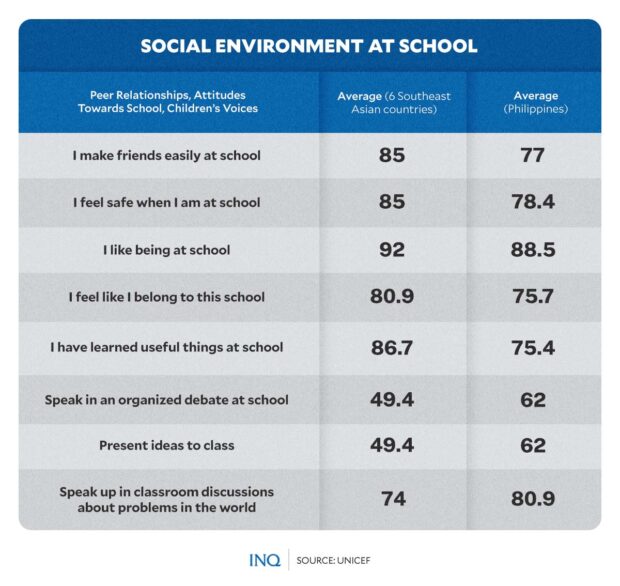
GRAPHIC Ed Lustan
But children in the Philippines had the lowest average, with only 77 percent of children finding it easy to make friends at school. Children in Vietnam had the highest average at 94.4 percent, even higher than the 85 percent regional average.
“Children’s social skills and ability to make friends could positively affect their academic accomplishments over time, as studies indicate that learning performance is related to peer experiences,” Unicef said.
READ: Stabbing in QC school shines light on urgency of addressing campus violence in PH
On exposure to violence at school, the Philippines had the highest level of bullying at 63 percent, higher than Malaysia’s 25.9 percent, Vietnam’s 18.4 percent, Myanmar’s 13.2 percent, Lao PDR’s 4 percent, and Cambodia’s 2.4 percent.
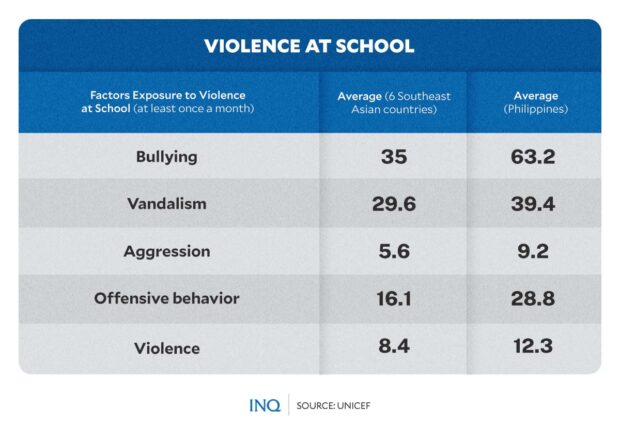
GRAPHIC Ed Lustan
The Philippines also had the highest levels of vandalism, aggression, offensive behavior, and violence, having an average of 39.4 percent, 9.2 percent, 28.8 percent, and 12.3 percent.
Children’s activities
Children’s activities–both in and out of school–are critical factors that affect learning.
Unicef, however, said how a child spends time may depend on a variety of dimensions such as parental involvement, socioeconomic conditions, safety and the availability of facilities in local communities.
Based on SEA-PLM 2019 data, the Philippines had the highest level of availability of playgrounds in local communities at 80.3 percent, but the availability of such in schools was the second lowest across the participating countries in the region.
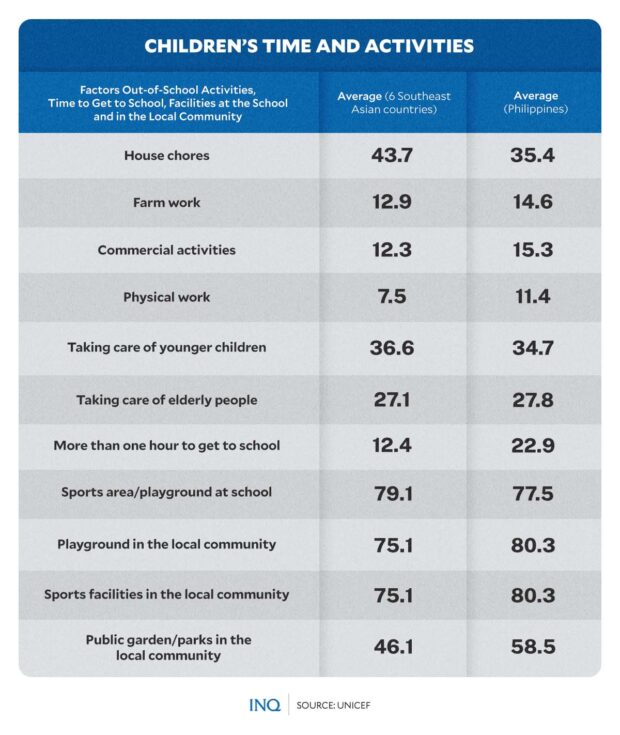
GRAPHIC Ed Lustan
The Philippines also had the highest percentage of children taking more than one hour to get to school at 22.9 percent, higher than Lao PDR’s 13.7 percent, Myanmar’s 11 percent, Malaysia’s 7.7 percent, Cambodia’s 5.2 percent, and Vietnam’s 1.3 percent.
Unicef said “the time children spend commuting can also affect their ability to learn. Long commutes can distract them from their learning tasks and interfere with their concentration in school, owing to fatigue.”
Notably, however, compared to the rest of the participating countries, there were fewer Filipino children who were engaged in out-of-school activities such as house chores (35.4 percent), farm work (14.6 percent), and commercial activities (15.3 percent).
Health, access to WASH
As explained by Unicef, besides making children’s immediate environments safe and secure, “health and nutrition were just as important in ensuring the physical well-being of children.”
It said “adequate water, sanitation, and hygiene (WASH) facilities in schools contributed to higher learning,” stressing that these services are especially important in the recovery from the COVID-19 crisis.
But Unicef said as of school year 2020-2021, the Department of Education found that 70 percent of local public schools nationwide still do not have the minimum facilities and provisions.
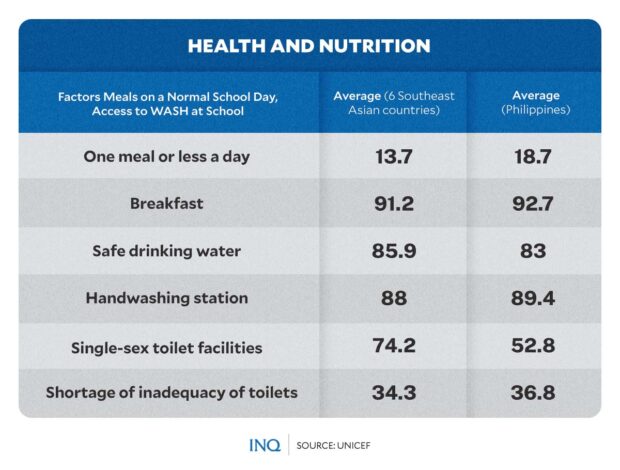
GRAPHIC Ed Lustan
Based on SEA-PLM 2019 data, access to single-sex toilets was second lowest in the Philippines at only 52.8 percent, lower than Cambodia’s 73.2 percent, Vietnam’s 95.6 percent, and Malaysia’s 96.2 percent.
READ: Lack of sanitation, clean water killing kids, says Unicef
Likewise, the lack of adequate nutrition was linked to lower scores.
Unicef said 18.7 percent of children in the Philippines get only one meal or even less a day, the highest compared to the rest of the participating countries in the region.
A previous report also found that despite more children surviving, millions of Filipino children are failing to grow well amid high levels of stunting, wasting, micronutrient deficiencies, and the fast-growing rates of being overweight and obesity.
A strong positive correlation was also found in most of the participating countries between children’s concern for environmental sustainability issues and their learning performance.
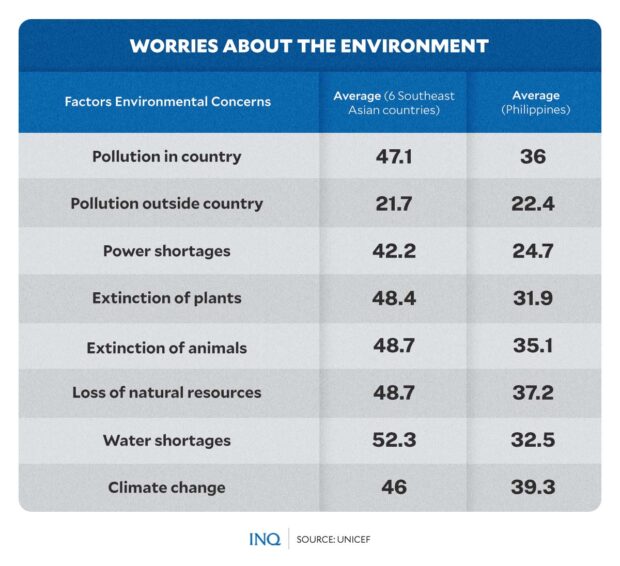
GRAPHIC Ed Lustan
“Studies have shown that the climate crisis disproportionately affects children who are already falling behind in their education, especially girls,” Unicef said.
READ: Humanity: Biggest obstacle to climate change
It stressed that countries that are at extremely high risk to climate change, like the Philippines, also have the lowest levels of primary school completion and foundational reading skills.
Gov’t needs to move
Unicef said governments across Southeast Asia “have an opportunity to reshape their approach to education so that children and adolescents are equipped with the necessary academic and socio-emotional skills to live a rewarding life.”
“The recent COVID-19 pandemic created an opportunity for governments and school systems to rethink how to approach children’s learning and to create policies for more resilient and inclusive societies,” said Unicef.
Unicef said it “recommends government institutions to work across sectors—schools, parents, and communities—to support learners through direct engagement and fostering supportive environments.”
As stressed by Unicef Philippines Representative Oyunsaikhan Dendevnorov, the report illustrated that a child’s wellbeing and learning outcomes are mutually reinforcing and interconnected.
“This is especially important for building foundational skills and during early adolescence when rapid physical, emotional, and social changes affect growth and development,” he said.
“The insights of children in this report will help government partners and schools to reflect on the current policies and practices and how they can be improved,” he added.